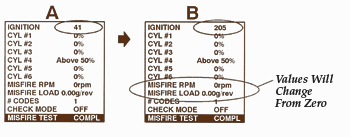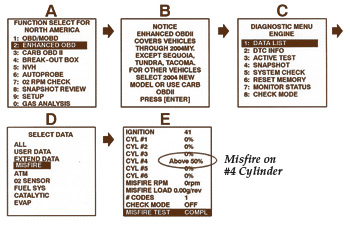Applicable Vehicles:
– 2001 model year Japan-built Camry vehicles equipped with 1MZ-FE engines (“6).
– 1998-2001 model year North American-built Camry vehicles equipped with 1MZ-FE engines (“6)
– 1998-’99 model year Avalon vehicles.
– 1998-2000 model year Sienna vehicles.
– 1999-2002 model year Solara vehicles equipped with 1MZ-FE engines produced before the production change, effective VIN 2T1CF2#P*2C578710.
Repair Procedure:
1. Confirm if the vehicle is currently misfiring, running rough or hesitating.
If YES – Go to Step 2.
If NO – Review Freeze-Frame Data and attempt to operate the vehicle under similar driving conditions. See notes below for information that makes it more likely to duplicate misfire.
Note: The following activities will turn off misfire detection:
• Changing engine rpm greater than 150 rpm.
• Changing throttle position quickly. See Fig. 1.
Misfire duplication can be duplicated most readily when the engine speed and throttle angle are held nearly constant for at least 2 minutes.
2. Confirm if the misfire is currently occurring on cylinder(s) identified by DTC(s) using the diagnostic tester while the engine is idling. See Fig. 2.
Is the cylinder(s) identified by the DTC(s) misfiring?
If YES – Go to Step 3.
If NO – Follow the normal diagnostics for the applicable DTC in the Technical Information System (TIS) in the applicable Repair Manual: Diagnostics: SFI: P030 #.
3. Swap the suspect ignition coil(s) from the cylinder that is misfiring to the cylinder that is not misfiring.
4. Using a diagnostic tester, confirm that the misfire is now occurring in the cylinder that has the suspect ignition coil(s). Has the misfire followed the swapped ignition coil(s)?
If YES – Replace the ignition coil(s) and go to Step 5.
If NO – Follow the normal diagnostics in TIS for the applicable Repair Manual: Diagnostics: SFI: P030 #.
5. Confirm that the misfire has been eliminated (0% at all times) using the diagnostic tester while the engine is idling.
Note: If the misfire percent is any value other than 0% at any time, then that cylinder is misfiring.
Technical service bulletin courtesy of Mitchell 1.
For more information on Mitchell 1 products and services, automotive professionals can log onto the company’s website at www.mitchell1.com.













